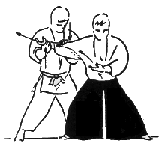 |
|
|
|
|
What is Aikido?Aikido is a modern Japanese martial art which emphasizes blending with an attacker's energy in the performance of self-defense techniques. Since aikido blends with, rather than fights, the incoming energy, great strength and size is not a requirement to successfully utilize aikido techniques. Aikido students learn to "read" the emotional and physical energy of an attacker in order to facilitate the performance of techniques to defend against grabbing, choking and striking attacks. Ki Aikido, developed by Master Koichi Tohei is a style of Aikido emphasizing the role of Ki energy in the performance of aikido techniques.
|
What is Ki Development?Everyone has a type of inner energy which we call Ki. You may develop your Ki through a variety of activities. For example, Ki breathing is a type of meditative exercise in which one breathes in through the nose, inhaling deeply, then releasing the air in a relaxed manner through the mouth, making a "hhhhaaaaaaa" sound as the air is expelled. By practicing Ki breathing a few minutes each day, you will develop strong Ki energy.
Aikido and Ki Development students learn a variety of physical exercises which promot Ki development, relaxation and a feeling of being centered, both mentally and physically. Remaining relaxed and centered in stressful situations is helpful not only in self-defense situations, but in daily life as well. |
|
Ki BreathingKi Breathing may be done in any position; the best position is when sitting seiza (kneeling). Ki Breathing should be done for 20 minutes at a time. You should be able to continue Ki Breathing for 30 minutes; this is a minimum goal to attain. Ki Breathing should be natural, not forced. Ki Breathing will allow you to consume more oxygen and expel more carbon dioxide than most breathing methods. Ki Breathing will energize and relax you at the same time. Ki Breathing will enhance your ability to coordinate mind and body. Ki Breathing will allow you to become more centered and positive. Correct Ki Breathing is difficult to master because just being able to sit still for 20 minutes at a time is a task in itself; so do not force it. Breath as long as you can until you feel the urge to stop; when this happens, it is time to stop. At first, breathing should be done at the same time every day at the same time. The next day, breath at least as long as you did the day before. Continue this process until you can reach the 30 minute goal. Remember that slow and consistent practice will allow you to benefit the most from Ki Breathing. I find that Ki Breathing, just before bedtime, will enable me to sleep more soundly and wake up faster, feeling totally rested. Ki Breathing is also helpful in finding solutions to problems. Concentrate on the problem at hand before you start to breath. Start breathing but do not think about the problem; when you finish Ki Breathing, you may have a better idea of how to solve your problem. If you get nervous, before a presentation or any stressful activity, Ki Breathing will allow you to relax and complete the task at hand with confidence and relaxed control. Instructions for Ki BreathingPosition yourself in the correct seiza posture; sitting kneeling..Lower back in..leaning slightly foward over your center. This will be referred to as the neutral position. Concentrate correctly; imagine your mind at your center (3 inches below your navel)..Iet your muscles naturally relax but do not collapse..focus your Ki (attention/energy) away from your body and your center. Exhale first: open your mouth and begin to let your breath flow naturally out. As you exhale, create the sound 'HAAAA" as softly as possible. Use your throat muscles to control the flow of your breath. If you do not control your breath, the exhalation will be done much too quickly. when you cannot exhale any longer, bend slightly foward from your center. This will compress the diaphragm and allow you to exhale a bit more. After shifting foward and exhaling completly, return to the neutral position and concentrate on your center, still imagining that you are exhaling. Remain in the neutral position for 5 seconds. The exhalation cycle should take 35 seconds in total...exhale for 30 seconds and hold for 5 seconds. Inhale next: close your mouth and begin to let the air flow naturally through your nose. Use your throat muscles to control the flow of your breath. If you do not control your breath, the inhalation will be done much too quickly. when you cannot inhale any longer, bend slightly backward from your center. This will expand the diaphragm and allow you to inhale a bit more. After shifting backward and inhaling completly, return to the neutral position and concentrate on your center, still imagining that you are inhaling. Remain in the neutral position for 5 seconds. The inhalation cycle should take 25 seconds in total..inhale for 20 seconds and hold for 5 seconds. Remember, do not force this exercise; if a 30 second exhalation is too much for you to do, then reduce the exhalation to 20 seconds or whatever feels right. But remember to also reduce the inhalation time to 2/3 of the exhalation time I Always hold the neutral position for 5 seconds, no matter how much the inhalation or exhalation times change. When inhaling and exhaling, imagine that your Ki is flowing along with your breath. This will allow you to maximize the effect of Ki Breathing to your overall well-being. I hope this will be helpful in this most important part of KI-AIKIDO. By Hal Singer |

